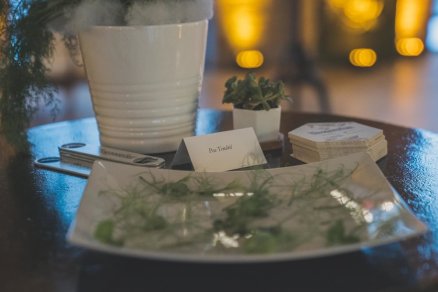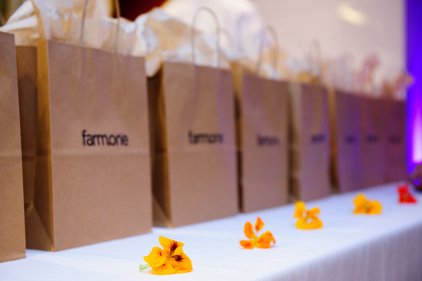 You can click on any of these photos to go to their source, and they are inserted here because the article that brought this farm (?), this company, this phenomenon to my attention did not have any images. It was good to have only the New Yorker words to start with because, like all good writing, it forced me to imagine what this might look like. However, my imagination fell short.
You can click on any of these photos to go to their source, and they are inserted here because the article that brought this farm (?), this company, this phenomenon to my attention did not have any images. It was good to have only the New Yorker words to start with because, like all good writing, it forced me to imagine what this might look like. However, my imagination fell short.
Out of the Ordinary
Farm.One is New York City’s grower of rare herbs, edible flowers and microgreens for some of the best restaurants in the city. Our Edible Bar and Tasting Plates make these fresh, exciting ingredients available for the first time in an event setting. Guests can discover botanical ingredients for the first time, with the expert guidance of our farm team. Taste ingredients on their own, or paired with cocktails and other beverages, for a colorful, flavorful and aromatic experience like no other.
 This short piece by Anna Russell below continues our stream of thought about the farm of the future, and takes it into very unexpected territory. Hydroponics and urban farming have been featured many times in these pages over the years so that is not what has our attention. It is the mixing of art and agriculture that gets us thinking outside the box:
This short piece by Anna Russell below continues our stream of thought about the farm of the future, and takes it into very unexpected territory. Hydroponics and urban farming have been featured many times in these pages over the years so that is not what has our attention. It is the mixing of art and agriculture that gets us thinking outside the box:
Tribeca’s Hydroponic Underground
Chic stems and tender greens thrive deep below Worth Street on the rolling shelves of Farm.One.
Hydroponics are a slippery slope. You might find yourself, one Sunday morning, at a Santa Monica farmers’ market, loitering among the apples, say. You come across a bunch of papalo, a leafy herb native to central Mexico, and toss it in your mouth (your tastes are expansive; a papalo leaf is nothing to you) and wham!: a brand-new flavor. Suddenly, you’re up at all hours, watching vertical-farming videos on YouTube, ordering seed packets from eBay, buying rhizomes—rhizomes!—and worrying about spider mites. You get some fennel crowns and a pouch of parasitic wasps, and you’re on your way.
On Worth Street, in Tribeca, deep underground beneath the New York Eye and Ear Infirmary and the Michelin-starred restaurant Atera, lies Farm.One, Manhattan’s largest hydroponic farm. That’s distinct from aquaponics (farming with fish) and aeroponics (farming with air and nutrient-dense mist), explained Rob Laing, a thirty-eight-year-old Australian tech entrepreneur, who, in thrall to papalo, set up the farm two years ago. “We, sadly, don’t have any fish,” he said the other day. “It’s enough difficulty to get the plants to be happy.” A year ago, Farm.One, having overgrown its original home, at the nearby Institute of Culinary Education, was invited by Atera, a client, into the restaurant’s subterranean space. At twelve hundred square feet, the digs are roomier, but, “agriculturally, it’s still pretty tiny,” Laing said.
Laing was standing next to a floor-to-ceiling rack of neatly labelled seed packets, in a small antechamber of the farm. He had on a black smock, jeans, and rubber clogs. The greens were visible through a window next to a pressurized door designed to keep out pests. “We have microgreens, rare herbs, and edible flowers,” he said. He held up a seed packet. “The first seed we ever bought was akatade, which is like a spicy Japanese water pepper. And then amaranth. It’s red, like the grain, but it’s a microgreen.”
Rounds begin each morning at 6:15, David Goldstein, a hydroponicist at the farm, explained. He listed some of the responsibilities: “Planting, harvesting, general upkeep, maintenance of the hydroponic systems, testing the water we use in the hydroponic systems, the cleaning of that water.” Later, the greens are packed into boxes for delivery, by bicycle or by subway, to restaurants around the city (nasturtiums for Jungsik, dianthus flowers for Freemans). In the evening, the foodies arrive for a “sensory farm tour”—a “glass-of-prosecco-type thing,” Laing said.
There’s no earth to commune with at Farm.One per se (hydroponic systems are soil-free), but sometimes chefs stop by to browse. One recent afternoon, Alex Guarnaschelli, a Food Network star and the executive chef at Butter, visited for the first time. Laing handed her a hairnet, shoe coverings, and a lab coat, which she slipped on over a pink sweater. “This is to stop you from bringing pests into our farm,” Laing explained, apologetically.
“A chef gets dressed and undressed twenty times a day!” Guarnaschelli said. The door to the farm opened with a whoosh, and they entered. The plants sat on rolling shelves, like books in a library basement. Everyone applied Purell.
“We have some sorrel here that was planted, like, two weeks ago,” Laing said. He handed Guarnaschelli a leaf.
“I’ve eaten this so many times,” she said. “It’s delicious. You know that taste of stevia that’s good? It has that acrid note, right at the back of your tongue.”…
Read the whole article here.